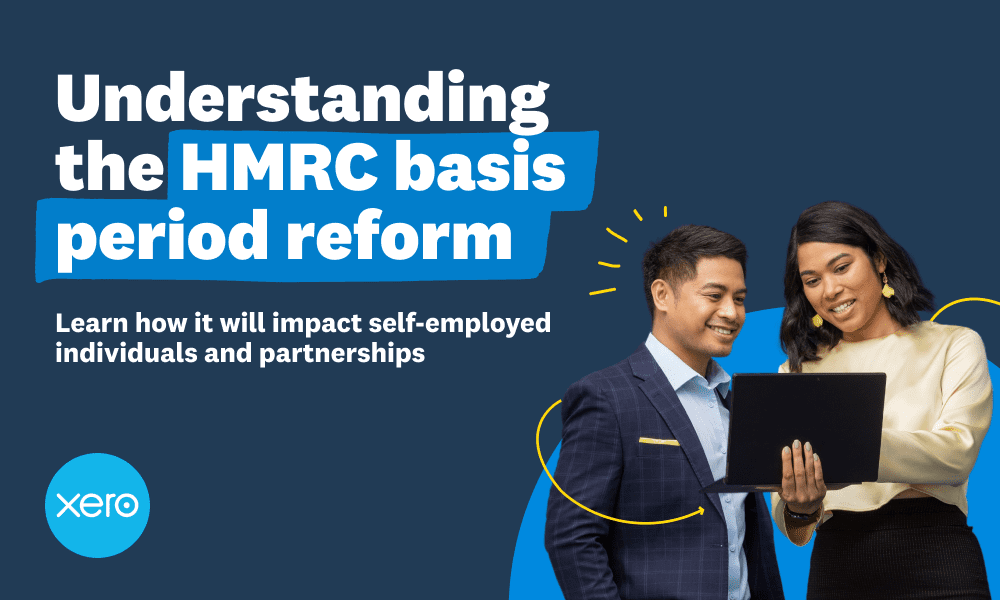
How Xero can support you with Basis Period Reform
LAST UPDATED: Mar 21, 2024

The start date for Basis Period Reform is fast approaching. From April 2024, your sole trader and partnership clients will need to follow a tax year basis for Income Tax as part of HMRC’s Basis Period Reform.
The reform is only expected to impact 7% of sole traders. However, 33% of partnerships are likely to be affected.
The 2023/24 tax year is a transitional period, and you’ll need to do some extra admin to make sure your sole trader and partnership clients are compliant. We explore how to prepare for Basis Period Reform and how Xero can support you.
What is Basis Period Reform and who’s affected?
As outlined above, Basis Period Reform is a change to the reporting period used for Income Tax purposes. The measure impacts sole trader and partnership clients who use their own accounting year for Income Tax reporting.
Going forward, you’ll need to report the profits clients generate in the tax year on their Income Tax Return, instead of the profits they generate during their accounting year. Clients who already use the tax year basis won’t need to make any changes.
Some of your clients might decide to change their accounting date, in order to simplify Income Tax reporting. HMRC counts any date between 31 March to 5 April as tax year-aligned, but clients can still keep their original accounting date if needed. For instance, if your clients work in seasonal industries such as farming, they may choose to keep a September accounting date because this is their quietest period.
Note: businesses that begin operating from 6 April 2024 will automatically use the tax year basis.
Why is the new basis period coming into place?
Basis Period Reform will mean profits are taxed closer to the time they’re earned. According to HMRC, this will make tax planning easier for businesses, improve compliance, and reduce tax debt write-offs. It means all sole traders and partnerships will be taxed within the same period.
Property income, interest, and dividends are already taxed on this basis. Through Basis Period Reform, the Income Tax system will be aligned with these other income types. You’ll use the same reporting period for your clients, for all of these income types.
There’s an additional benefit to adopting a tax-year basis now. When Making Tax Digital (MTD) for Income Tax comes into place, sole traders and landlords will be required to submit quarterly updates in line with the tax year. By shifting to a tax-year basis now, you and your clients can get comfortable with tax-year reporting ahead of time.
What are the two phases of Basis Period Reform?
First, a transitional period for the 2023/24 tax year. Clients with a year-end date that doesn’t align with the tax year will have an extended basis period for their 2023/24 tax year. You’ll need to apportion profits from two sets of accounts that make up the tax year to file their Income Tax Return.
Then, Basis Period Reform will take full effect in the 2024/25 tax year. All sole traders and partnership clients must use the tax year basis. Some of your clients might choose to align their accounting dates with the tax year to simplify their reporting requirements. For clients who wish to keep their accounting date, you’ll need to continue apportioning profits as you did in the transitional year.
How does the transitional period work?
For clients who aren’t already following the tax year basis, you’ll need to apportion profits from two sets of accounts to complete their 2023/24 Income Tax Return. Let’s look at an example:
Your client, Maria, has a 31 December year-end.
Her basis period for the 2023/24 tax year has two parts:
- Her accounting year: 1 January 2023 – 31 December 2023
- Plus, the transitional part: 1 January 2024 – 31 March 2024
In total, Maria will be taxed on 15 months’ profit for her 2023/24 Income Tax Return. For an in-depth guide on calculating transitional profits, check out the HMRC website.
During this transitional period, tax bills are likely to be higher for clients who don’t already use the tax-year basis. To accommodate higher tax bills, HMRC is allowing taxpayers to spread these overlap profits over five years and cushion the impact on their cash flow.
Some of your clients may also be entitled to overlap relief if they started trading with a non-tax year-aligned accounting date. You can claim this on their behalf during the transitional year if you have access to the additional tax amounts. HMRC is also working on an online form to request clients’ overlap profit figures directly.
Managing transitional profits might sound like an added layer of complexity. But we’ve made updates to Xero Tax which means you’ll be able to include transitional profit claims and basis period adjustments on self-employment and partnership income worksheets.
How can you prepare your practice and clients for the new measure?
Clients will look to you in the coming months for advice and guidance on the measure. They’ll need your help with apportioning profits, switching accounting dates, and understanding the legislation.
Your practice will also see an increase in admin. For clients who aren’t using the tax year basis already, you’ll need to apportion profits from their two accounting periods that fall within the tax year. If they decide to keep their accounting date, you’ll need to do this for every Income Tax Return going forward. That could mean preparing multiple sets of accounts for clients, every year.
And for those who have an accounting date that falls after September, you might struggle to finalise figures ahead of the 31 January deadline. Instead, you’ll need to submit provisional figures to HMRC and confirm these estimates when you submit clients’ following Tax Returns. This essentially means you’re filing two returns per client, each year.
If this sounds overwhelming, rest assured that there are tools to help you tackle the admin. Cloud-based software for accountants and bookkeepers can automate daily bookkeeping tasks and provide you with accurate and reliable transaction data for clients. This can then be used to apportion profits, report income, and provide provisional figures.
Xero is now fully prepared to support you with any Basis Period Reform adjustments. You can easily extend your financial year-end date without any disruption to fixed asset depreciation. Enjoy clear, streamlined tracking and reporting of transitional data, including transitional profit claims and basis period adjustments.
For more guidance, watch our latest on-demand webinar that outlines how to manage Basis Period Reform changes in Xero or take a look at our complete guide to Basis Period Reform and Xero Central page on Basis Period Reform.
Share this article
[addtoany]


